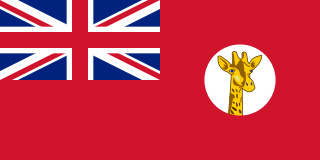The African Great Lakes nation of Tanzania dates formally from 1964, when it was formed out of the union of the much larger mainland territory of Tanganyika and the coastal archipelago of Zanzibar. The former was a colony and part of German East Africa from the 1880s to 1919’s when, under the League of Nations, it became a British mandate. It served as a British military outpost during World War II, providing financial help, munitions, and soldiers. In 1947, Tanganyika became a United Nations Trust Territory under British administration, a status it kept until its independence in 1961. The island of Zanzibar thrived as a trading hub, successively controlled by the Portuguese, the Sultanate of Oman, and then as a British protectorate by the end of the nineteenth century.

Julius Kambarage Nyerere was a Tanzanian anti-colonial activist, politician, and political theorist. He governed Tanganyika as prime minister from 1961 to 1962 and then as president from 1962 to 1964, after which he led its successor state, Tanzania, as president from 1964 to 1985. He was a founding member and chair of the Tanganyika African National Union (TANU) party, and of its successor Chama Cha Mapinduzi, from 1954 to 1990. Ideologically an African nationalist and African socialist, he promoted a political philosophy known as Ujamaa.

Abeid Amani Karume was the first President of Zanzibar. He obtained this title as a result of a revolution which led to the deposing of Sir Jamshid bin Abdullah, the last reigning Sultan of Zanzibar, in January 1964. Three months later, the United Republic of Tanzania was founded, and Karume became the first Vice President of the United Republic with Julius Nyerere of Tanganyika as president of the new country. He was the father of Zanzibar's former president, Amani Abeid Karume.
The Tanganyika Rifles was the sole regiment in the Tanganyikan army, from 1961 to 1964.

The Uganda–Tanzania War, known in Tanzania as the Kagera War and in Uganda as the 1979 Liberation War, was fought between Uganda and Tanzania from October 1978 until June 1979 and led to the overthrow of Ugandan President Idi Amin. The war was preceded by a deterioration of relations between Uganda and Tanzania following Amin's 1971 overthrow of President Milton Obote, who was close to the President of Tanzania, Julius Nyerere. Over the following years, Amin's regime was destabilised by violent purges, economic problems, and dissatisfaction in the Uganda Army.

The Zanzibar Revolution occurred in January 1964 and led to the overthrow of the Sultan of Zanzibar and his mainly Arab government by the island's majority Black African population.
John Gideon Okello was a Ugandan revolutionary and the leader of the Zanzibar Revolution in 1964. This revolution overthrew Sultan Jamshid bin Abdullah and led to the proclamation of Zanzibar as a republic.

The Sultanate of Zanzibar, also known as the Zanzibar Sultanate, was a Muslim state controlled by the Sultan of Zanzibar, in place between 1856 and 1964. The Sultanate's territories varied over time, and after a period of decline, the state had sovereignty over only the Zanzibar Archipelago and a 16-kilometre-wide (10 mi) strip along the Kenyan coast, with the interior of Kenya constituting the British Kenya Colony and the coastal strip administered as a de facto part of that colony.
Abdulrahman Mohamed Babu was a Zanzibar-born Marxist and pan-Africanist nationalist who played an important role in the 1964 Zanzibar Revolution and served as a minister under Julius Nyerere after the island was merged with mainland Tanganyika to form Tanzania. He was jailed by Nyerere from 1972 and, after his release following an international campaign, remained a vocal critic of imperialism, authoritarian states and excessively statist development models.

Oscar Salathiel Kambona (1925-1997) was the first Minister of Foreign Affairs of Tanganyika from 1963 to 1966.
People have lived in Zanzibar for 20,000 years. History properly starts when the islands became a base for traders voyaging between the African Great Lakes, the Somali Peninsula, the Arabian peninsula, Iran, and the Indian subcontinent. Unguja offered a protected and defensible harbor, so although the archipelago had few products of value, Omanis and Yemenis settled in what became Zanzibar City as a convenient point from which to trade with towns on the Swahili Coast. They established garrisons on the islands and built the first mosques in the African Great Lakes Region.

Tanganyika was a colonial territory in East Africa which was administered by the United Kingdom in various guises from 1916 to 1961. It was initially administered under a military occupation regime. From 20 July 1922, it was formalised into a League of Nations mandate under British rule. From 1946, it was administered by the UK as a United Nations trust territory.

Operation Parthenon was a British plan for military intervention in Zanzibar following the 1964 revolution. The operation was authorised by the British Commanders Committee East Africa on 30 January. The main objectives were to restore law and order in Zanzibar and to prevent the radical left-wing Umma Party from taking control of the government from the moderate Afro-Shirazi Party. The forces assigned to the operation included two aircraft carriers, three destroyers, a Royal Fleet Auxiliary vessel, 13 helicopters, 21 transport or reconnaissance aircraft, a battalion of Foot Guards, a battalion of Royal Marines and an independent company of paratroopers. The plan was to launch a helicopter and parachute assault of Unguja, Zanzibar's main island, before proceeding to take the smaller island of Pemba. If it had been carried out, Parthenon would have been the largest British airborne and amphibious operation since the Suez Crisis of 1956. Parthenon was scrapped around the 20 February and replaced with Operation Boris.

Operation Boris was a British plan for military intervention in Zanzibar following the 1964 revolution. It was devised around 20 February to be used if the radical left-wing Umma Party attempted to take power. It replaced the earlier sea-based Operation Parthenon with a parachute assault launched from Kenya. However the operation was not required and was jeopardised by the lack of co-operation from the Kenyan government and populace for an attack on Zanzibar. Boris was replaced by Operation Finery, an amphibious helicopter assault, on 9 April 1964.

Operation Finery was a British plan for military intervention in Zanzibar following the 1964 revolution. It was a replacement for the earlier operations Parthenon and Boris, amphibious and airborne assaults. Finery circumvented the reliance of the previous plans on bases in Kenya, where government and local support for intervention were not forthcoming. Instead, Finery would have utilised the commando carrier HMS Bulwark to land Royal Marines on Zanzibar to protect Karume's government. Because of delays in the deployment of Bulwark, Finery was supplemented by Operation Shed, which could be launched at shorter notice. The expected coup did not occur, and Finery was scrapped on 29 April 1964, although Operation Shed remained in place.

Operation Shed was a British plan for military intervention in Zanzibar following the 1964 Zanzibar revolution. It was one of a series of operations devised by the British to be implemented in the case of an attempt to seize power from President Abeid Karume by the radical left-wing Umma Party. Shed succeeded the earlier Operations Parthenon and Boris and was an alternative to Operation Finery. Shed would have involved an airlift of a battalion of troops to Unguja to provide support to Karume and to protect European citizens. The risk of a coup passed by 29 April 1964 and it was determined that any intervention would be opposed by Karume's forces and a Soviet training team. With this in mind Shed was modified on 9 June to an airborne assault by Royal Marine commandos from HMS Centaur, which would then be supported by the landing of a battalion and armoured cars from Kenya. The continuing presence of British and friendly nationals in Zanzibar complicated the matter and, around 23 September 1964, Shed was replaced by Plan Giralda.

The People's Republic of Zanzibar was a short-lived African state founded in 1964, consisting of the islands of the Zanzibar Archipelago. It existed for less than a year before it merged with Tanganyika to create the United Republic of Tanganyika and Zanzibar, which would be renamed to Tanzania in October of that year.
Freedom of religion in Tanzania refers to the extent to which people in Tanzania are freely able to practice their religious beliefs, taking into account both government policies and societal attitudes toward religious groups.

Tanzania–Turkey relations are the foreign relations between Tanzania and Turkey. The Turkish embassy in Dar es Salaam first opened in 1979, although the Ottoman Empire had previously opened a consulate in Zanzibar, now a part of Tanzania, on March 17, 1837.

The 1972 invasion of Uganda was an armed attempt by Ugandan insurgents, supported by Tanzania, to overthrow the regime of Idi Amin. Under the orders of former Ugandan President Milton Obote, insurgents launched an invasion of southern Uganda with limited Tanzanian support in September 1972. The rebel force mostly consisted of the "People's Army" whose forces were mainly loyal to Obote, but also included guerillas led by Yoweri Museveni. The operation was hampered by problems from the start, as a planned rebel commando raid had to be aborted, Amin was warned of the impending invasion, and the rebels lacked numbers, training, and equipment. Regardless, the militants occupied a few towns in southern Uganda at the invasion's start. However, no major popular uprising erupted as Obote had hoped.











